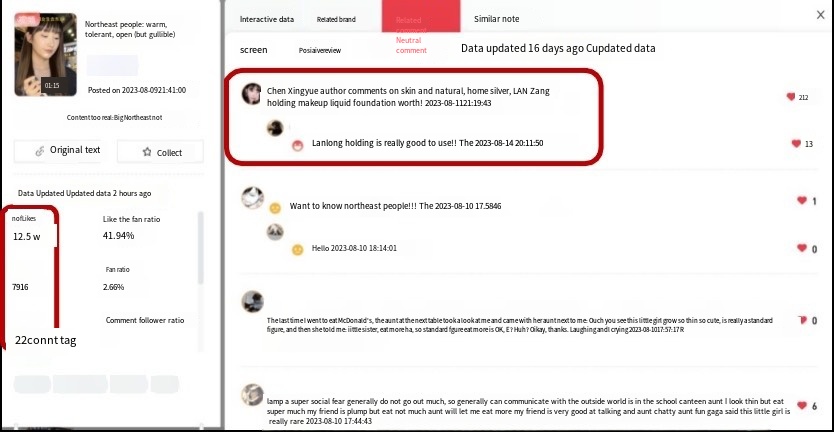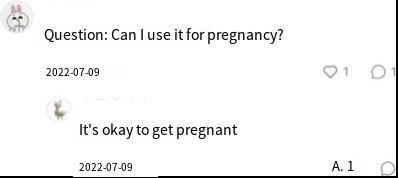1. Introduction
As technology advances and social media generalizes, almost everyone is in touch with social media. Globally, social media platforms such as Twitter, Instagram, Facebook, Snapchat, WeChat, etc. Nonetheless in Chinese society, a newborn platform named Xiaohongshu (RED) is gaining popularity.
Due to the broad user base and powerful social network effects of social media platforms, they are not only used for daily communication and building connections but also for advertising and product promotion. This enables advertisements and product promotions to spread information more quickly and widely. Social media marketing has become an integral part of modern marketing strategies.
RED, as a platform for sharing lifestyles, has become an essential channel for consumers to acquire product information and make purchases. The RED shopping platform has a well-rounded content ecosystem where valuable products, reviews, tutorials, and other content seamlessly integrate into the shopping scene, creating its unique shopping culture. RED boasts 260 million monthly active users, with over 3 million notes published every day. One of the most common user comments on RED is seeking links (in Chinese 求链接). Statistics show that the platform receives approximately 3 million daily comments requesting purchase links, with a daily average of 40 million users seeking to make purchases. With the rise of the new generation of young consumers and the prevalence of online shopping, RED’s shopping platform has a broader market space. On the platform, KOLs (Key Opinion Leaders) are enthusiastic about sharing product reviews and personal recommendations, while consumers like to make consumption decision searches within RED, while customers take advice from RED and purchase things on shopping platforms or even within RED. In this sense, the influence of KOLs on social media is growing stronger.
The RED shopping platform has established close partnerships with numerous brands and KOLs. This collaboration not only provides brands with more exposure opportunities but also offers users more reliable consumption references. KOLs have become a vital channel for brand promotion, allowing brands to connect directly with their target audiences. KOL content is often more authentic, relatable, and capable of rapid dissemination on social media. By collaborating with KOLs, brands can increase product awareness, trustworthiness, and sales through the voices and influence of these influential individuals.
As of August 2023, more than 170,000 brands have joined RED. Despite brands establishing their official accounts, unlike platforms like Twitter and Instagram, brand official accounts on RED receive less attention, and the engagement metrics for their published notes are significantly lower than those of KOL accounts. This article approaches the topic from the perspective of the influence of social media influencers on consumers and takes the well-known high-end cosmetics brand Lancôme as an example to delve into the success factors of Lancôme's promotional strategies on RED. It particularly focuses on why KOLs' promotional efforts are more attractive to consumers than official brand accounts.
Therefore, we pose the following questions:
1. What are official brand accounts' advertising content and responses on social media?
2. What are the advertising content and responses of KOLs on social media?
3. What are the reasons for these differences?
2. Literature Review
2.1. Opinion Leaders, Social Media Marketing, and Consumers
In the past decade, several scholars have engaged in discussions regarding digital media marketing. They have indicated that with the emergence of Web 2.0, marketing has shifted from traditional action-oriented strategies to interactive strategies. This shift implies that online advertising involves bidirectional communication rather than one-way dissemination [1]. Due to the rapid development of online social media, it has become the primary channel for information exchange. Some new events or terms can quickly aggregate collective attention and evolve into trends within a remarkably short timeframe [2].
Furthermore, the academics have expressed a growing interest in opinion leaders. In recent years, influencer marketing has gained prominence as a specific form of social media marketing highly regarded by marketers. Influencers, due to their skills, specific knowledge, or personalities [3], can exert significant influence on consumers through their viewpoints and recommendations. Opinion leaders wield influence, particularly in the political sphere, as the general public increasingly shifts towards social media, engaging not only in interaction, consumption, and content creation but also in discussions regarding news and political information. These behaviors on social media have substantial political consequences [4]. In the business domain, opinion leaders also play a pivotal role. In marketing, individuals with influence are referred to as opinion leaders or Key Opinion Leaders (KOLs). They typically possess specific knowledge or skills and wield a certain degree of influence on social media, and the content they disseminate can impact consumer decision-making [5]. However, variations in the definition and categorization of opinion leaders exist, necessitating further research for conceptual clarity.
2.2. Influencer Advertising, Social Media Marketing, and Consumers
Influencer advertising is a central focus of this study and differs from traditional advertising in that it leverages social media opinion leaders to promote products and services. Social media influencers were initially explored in the realm of advertising, especially in younger markets, aiding brands in expanding their social media exposure [6]. With the widespread use of social media and online stores, an increasing number of companies in the cosmetics industry support social media influencers [7]. While influencer advertising has become a part of digital marketing, its effectiveness has sparked debate. Some studies highlight its potential advantages, but others point out potential drawbacks.
Consumers may place more trust in social media influencers when they promote products using their expertise, positively influencing consumer attitudes and intentions to purchase cosmetics [7]. However, research indicates that a significant portion of consumers remain skeptical, believing that influential individuals endorse products solely for compensation. This suggests that many consumers hold a skeptical view of influencer advertising. Surveys also indicate that influencers must possess more than just attractiveness or a successful personality for successful promotion; high-quality products and trustworthy influencers are equally essential. Additionally, promoting an unsuitable product can damage one's reputation and popularity due to the influence of the influencer's personality [3]. To maximize their impact on consumers, influencers should select high-quality products suitable for promotion.
From another perspective, marketers should carefully choose appropriate social media influencers to foster positive consumer attitudes and influence their purchase intentions [6].
Research has shown that as many as 44.5% of respondents trust athletes the most, followed by experts (36.8%). Consumers place greater emphasis on influencers' skills and expertise. Therefore, when seeking influencer collaborations, companies might consider professionals or experts [3].
So, how should marketers select the right influencers for advertising campaigns? In the aspect of identifying the effectiveness of social media influencers, previous literature has lacked a unified classification for influencers, leading to variations in research findings in this regard.
2.3. Word-of-Mouth Marketing, Social Media Marketing, and Consumers
A critical point to consider in brand promotion decisions is the attitudes of target customers, and brands should fully understand who influences them. Research indicates that over 75% of customers consult friends before deciding to purchase a product or service. In recent years, large organizations have begun to recognize the importance of word-of-mouth marketing [8]. The growth of social networking sites has transformed traditional word-of-mouth into electronic word-of-mouth (eWOM). Recommendations and comments on social networking sites persist for a longer time, and online users can read them globally at any time [9]. This suggests that brands should make good use of the internet and social media for dissemination, monitor consumer dynamics, and adapt marketing strategies accordingly. Consumer feedback on social media is also referred to as User-Generated Content (UGC), which includes buyers sharing their shopping experiences online, implying that potential buyers can also see them [10].
Therefore, marketers need to provide high-quality products and services to customers, which can help establish a good reputation and bond for the brand in social media networks [9]. As one of the fastest-growing areas in marketing, online word-of-mouth provides significant opportunities for marketers [11].
2.4. RED, Social Media Marketing, and Consumers
The innovation in digital technology has provided new tools and platforms for social media advertising, making the dissemination of ads more precise and effective. Xiaohongshu (RED) is a popular social media platform in China, especially among young female users. Users on this platform often share personal recommendations about products and services [12]. This platform allows us to understand the trends in the Chinese digital market and consumers' attitudes toward products and services. Despite the rapid development of the Chinese digital market, there is relatively limited research on the RED platform, leaving a noticeable gap in this field. This study aims to explore the significant role played by Key Opinion Leaders (KOLs) in advertising on the Chinese social media platform RED. Through brand marketing strategies and case studies on the RED platform, this research attempts to contribute to filling the gap in understanding how KOLs influence consumers' purchase intentions in the Chinese social media landscape.
3. Method
3.1. Participants
The participants of this study will be the official account of Lancôme on RED, KOL (Key Opinion Leaders) that posts on RED, and 5 users that will be asked about their thoughts towards the differences and the pros and cons of both KOL and the official account of Lancôme. In the process, the five users will be asked about their age, and other personal information to make sure that the data are valid for different ages of people.
3.2. Research Steps
This study uses three articles from the official account and five articles from KOL (Key Opinion Leader) on Red as sampling. While combining the data of the actual information and the user comments and interactions with the articles, we gathered source data. Furthermore, we interviewed five RED users about their opinions towards KOL and official accounts. Then, we took further actions to compare and illustrate the perspectives of customers towards the methods both KOL and officials try to advertise by the following steps.
Firstly, we searched the brand ranking list using the New Red database (data-based offered by the third party while containing data about RED) and found that Lancôme ranked first in the skincare category. In the relevant notes section, we found the most representative note in the KOL account and analyzed its likes, favorites, and comment content. This note was selected as a research sample as it reflects that KOL advertising is one of the most popular marketing strategies among consumers.
Secondly, we searched for Lancôme skincare products on the RED platform and selected four notes posted by different types of KOLs, which have a certain influence on the field of beauty and skincare. We analyzed the advertising content, including product introduction, user experience, promotional information, and brand characteristics. We studied the interaction between users and notes, including likes, favorites, and comments. We analyzed the nature of the interaction and readers' reactions to advertising content. We also explored the role of each KOL in the notes and how they collaborate and promote products with the brand.
Thirdly, we repeated the step in the second paragraph but with only three official posts and applied it to the official Lancôme account on RED and compared the data and content disparity.
Last, we conducted an in-depth interview with five Red Users individually to learn about their perspectives on the advertisements of KOL and Official Accounts. As Figure 1 shown, the participants comprise 3 male and 2 female, aged between 18 to 46, who reside in Guangzhou, Shenzhen, Wuhan, xxx, xxx, and xxx. The interview took 60 minutes and developed with several interview questions as follows:
Have you purchased some products that influencers recommended on social media?
1. What type of accounts do you watch?
2. Where do you purchase them after getting advertised?
3. What do you think is the difference between KOL and Officials?
4. What do you use official accounts for?
5. What type of source do you perceive KOL as?
We interviewed five RED users whose age varies from teenagers, graduates, workers, and middle-aged ladies. We asked them questions that exemplified why KOL is gradually surpassing official accounts in the sense of advertising. For instance, we gave pictures of the Lancôme official account post and KOL posts and asked them what they think is the essential difference between the two, and asked which one they prefer and why (see Table 1).
Table 1: Demographics of interviewees
Participant | Gender | Age | Occupation | Location |
P1 | Male | 18 | Student | Jinzhou |
P2 | Female | 26 | Teacher | Wuhan |
P3 | Female | 21 | Bank Teller | Shenzhen |
P4 | Female | 46 | Finance Officer | Shenzhen |
P5 | Female | 22 | Graduate | Guangzhou |
4. Results
4.1. Sample posts of Lancôme advertisements (KOLs)

Figure 1: Image source: XH.NEWRANK.CN (Likes: 125,000 Saves: 7,916 Comments: 2,235)
Using the note Northeastern people are warm, tolerant, and undefended but easy to cheat (in Chinese 东北人热情,包容,不设防但好骗) by the influencer Xingyue Chen as an example, this note is presented in video format, using a storyline to seamlessly integrate a Lancôme advertisement into everyday life scenarios. The video showcases the rich culture of China's Northeast region, portraying the warm and friendly image of Northeasterners, which resonates emotionally with users. As a result, users are more willing to engage, sharing their personal experiences in the comments section. This contributes to expanding the reach and impact of Lancôme's advertising. This note exemplifies that in advertising on RED, narrative-driven KOL advertisements are one of the most popular marketing strategies (see Figure 1).




Figure 2: Image source: RED (Likes: 7,021 Saves: 2,925 Comments: 568)
Taking the note This combination has forced my beauty camera to be laid off(in Chinese 这套组合 已经把我的美颜相机逼到下岗) by the influencer Gangya Xiaowang as an example, this note adopts the perspective of a product manager. It engages users through a combination of visual and textual content, accompanied by intriguing headlines and concise images. The note offers valuable information and practical advice to readers. It presents Lancôme products from the viewpoint of a professional product manager, helping consumers understand the product and addressing queries about skin types in the comments section. This type of note leverages KOL's knowledge and influence to effectively promote and advertise the brand (see Figure 2).



Figure 3: Image source: RED (Likes: 9,716 Saves: 1,205 Comments: 125)
Using the note Is this the happiness of not shutting up?! (in Chinese 这就是没有闭口的快乐吗?!) by the influencer Bao Shangen as an example, this note is presented in a visually appealing format, using images featuring the blogger holding the product and showcasing its effects. This presentation style entices followers to click on the content. The note then shares skincare tips in a personal and engaging tone. The influencer's popularity significantly influences the purchasing decisions of their followers. This type of note leverages the reputation and fan base of KOLs to effectively promote and advertise the brand (see Figure 3).


Figure 4: Image source: RED (Likes: 44,000 Saves: 2,342 Comments: 1,163)
Taking the note Truly appreciative! The 40°C high temperature has transformed my foundation makeup into this condition…(in Chinese 真的会谢!40°高温把我底妆变成了这样) by the influencer Li Kakka as an example, this note, presented in a multimedia format, employs an attention-grabbing headline and comically unconventional images to captivate user clicks. It then humorously describes the brand's product in the textual content. The blogger closely follows real-time trends, creating amusing content that induces genuine laughter from their followers. Such content not only endears the blogger to their audience but also garners their affection and attention. These types of commercial notes typically possess a high level of interactivity and contribute to establishing a positive brand image among the young consumer demographic, thereby enhancing brand exposure (see Figure 4).




Figure 5: Image source: RED (Likes: 2,359 Saves: 2,438 Comments: 115)
Using the note An In-Depth Discussion of Lancôme's Advanced Génifique Hydrogel Melting Mask (in Chinese 浅谈兰蔻极光水的理解) by the influencer Formulation Expert Andy as an example, this is a text and image-based skincare knowledge-sharing note. It employs a skincare knowledge-sharing style title and simple, authentic images to attract user clicks. The note is presented from the perspective of a formulation expert, providing professional insights and practical usage experiences about the brand's product. The formulation expert can respond to fans' questions about skin types in the comments section, adding credibility and professionalism to the content. Such commercial notes by KOLs with relevant professional knowledge are trusted by their followers, who often actively engage with their promotional content (see Figure 5).
4.2. Sample posts of Lancôme advertisements (Official Account)


Figure 6: Image source: RED
The likes of the following pictures have not passed 22 likes while the comment under was also at most 7. Moreover, the collection number was 6 for all the three. Although the official account has gained 443000 fans, the likes, and comments they received are still seldom. The reason that caused this phenomenon to occur is probably because the fans followed the account for its popularity and global reputation. This could demonstrate why the data for official posts have tended to be low since the fans who subscribed to the account may not be people who finish reading or watching the things being posted. On the other hand, the main content and pictures the account posts about were photos of celebrities that endorsed the product/brand while there were also pictures of the product. The videos that the account posted were activity scenes, new product advertisements, and videos recorded by endorsing celebrities. The videos seem less attractive than the contexts since they are packaged in an advertising way, which readers do not typically like. Overall, the degree of activity in the KOL posts has significantly exceeded the ones in the official Lancôme account(see Figure 6).
4.3. Interview Results
After reading Lancôme’s official posts on RED, we concluded with four main features of these texts. To begin with, the colors and the images they have on the front page are extremely tedious and innovative. They have the same background color on almost every post. This gives readers a feeling of visual fatigue and lowers their interest. Secondly, the context Lancôme has written on each of their posts is overly formal and directly corresponds to the product in the picture. This could make their sales promotion intentions easily identified and make customers feel bored. Third, the celebrities Lancôme chooses to advertise their product are sometimes not sufficiently influential, meaning they may not meet the current hotspot of the crowds. Last, the user of the official Lancôme account does not actively interact with users that comment below. This means that some confusions that readers have about the product will not be answered directly, they will either find other accounts that match their needs, or they will have to search for it themselves. In conclusion, the official account of Lancôme on RED has maintained its serious and formal appearance, but it may not seem appealing to its potential customers.
From the results, it can be concluded that:
1. KOL accounts adopt a content strategy that is more relatable to consumers, sharing a greater number of experiences with Lancôme products in everyday life scenarios. This approach resonates with users and arouses their curiosity.
2. On the other hand, official accounts emphasize product features and promotional activities in their content strategy. Compared to the down-to-earth style of KOL accounts, official accounts appear more formal and commercial, potentially creating a sense of distance from consumers.
3. Interaction data and user feedback on KOL accounts show that users tend to trust and rely on the genuine usage experiences of other consumers, rather than official product descriptions (see Table 2).
Table 2: Interview Feedback
Participant | KOL | Official Account |
P1 | 1. A neutral-toned speaker while sharing personal experience. 2. Illustrates the pros and cons of a product 3. More vivid descriptions of products | 1. Introduces procedures and components to create a product 2. Brief impression and knowledge about the product 3. Information may get tedious |
P2 | 1. Use KOL as lnformation collecting source. 2. Shares their experience regarding to products. 3. Explain certain products is only applicable to a particular group | 1. Shopping platform/method 2. As more ways to receive information comes out, people may lose interest to officials. |
P3 | 1. Closer to their experience of the product 2. More useful for customers 3. More neutral toned | 1. Concise word choices 2. Advertisement 3. Gaining profit |
P4 | 1. Application of product and explain why. 2. Make sure customers understand the product. 3. More interactions with customers | 1. Standardized advertisement 2. Not very appealing 3. Introduce product with summarized words. |
P5 | 1. Set interesting plot to introduce the products. 2. Using experience shared by influencers are more reliable. 3. Influencers could use more attracting hashtags/title/slogans. 4. Influencers have loyal and stable followers——their promotion can reach consumers more directly/effectively. 5. Influencers are closer with followers, have more interaction. 6. Influencers understand and grab attention of potential consumers. | 1. Marketing strategies of official accounts are less appealing. 2. Official accounts are exaggerating the formula or technology. 3. The official account is always restricted by regulation/rules/brand reputation. |
5. Discussion
“In the contemporary globalized marketing using social media, this role is taken over by the influencers who affect consumers with their thoughts, attitudes, and opinions and thus, significantly influence trends in demand for particular products.” [3], shows the importance of influencers in modern marketing decisions. In our study, we further reflected on the importance of influencers and KOL in our society while social media is universally used. The goal of our study was to explore KOL's impacts on Chinese society and was achieved overall since we have reached an extent where we can answer and fill up the gap of the missing research for Chinese marketing. We concluded with multiple reasons for the impact KOL has on social media, in particular RED and marketing regarding the brand Lancôme. The research results were rigorous and convincing since we have incorporated multiple means to acquire information form. During the research, we looked at parts of different social media accounts from different KOLs while advertising and promoting sales of the brand Lancôme, we looked at various posts of the official Lancôme account and summarized data, and we interviewed 5 users of different ages, different jobs/occupations, and in different jobs. During the research, we have analyzed key points of the KOL posts. They were the novel ways and interesting titles they have included in the content to attract customers, their genuine reflection about the usage and their experience on the product, and their neutral tone and more approachable feelings they provide to customers are all their advantages. In addition, we analyzed the official posts of the Lancôme account. We then concluded with the following points: they have repetitive information, revealing too strong emotions and intentions in advertising their product, and they barely interact with audiences/readers, which makes the account unapproachable. Furthermore, we interviewed five users, and they shared their opinions on the reasons that KOL may be more attractive and appealing compared to official accounts while we provided pictures of both KOL and officials. In summary, they mostly talked about how they think KOL seems more attractive to them because they think KOL is unbiased while officials have their intentions already revealed by their titles and pictures. In addition, they also talked about how officials are more professional while KOL seems more like one of their friends sharing their thoughts and user experience privately. Therefore, the goal of exploring the reasonings and effects that KOL brings and has on Chinese online marketing and advertising has been achieved because we have put in the effort and time to analyze and find different aspects of this question.
In the research, there were also noticeable highlights and crucial knowledge that should be shared with the public. During the interview, we noticed that almost every interviewee mentioned the more approachable feeling that KOL has provided them. They have stated this thinking by using phrases such as KOL uses a more gentle and mild way to present their information, KOL uses a more neutral tone as an introducer to the product, and how KOL tells people about certain disadvantages regarding the product, which gives audiences a better feeling. This may suggest that in future advertisements for officials, they can use a more amiable tone and style to exhibit their videos/posts to attract and receive more possible customers. The other common key point that most of the interviewees have mentioned is the essential difference between the content of officials and KOL. They talked about how KOL focused on the product by sharing their personal feelings about it and why, while officials talked about the production of the product, and why is it good. Although the two may seem similar, the feelings they provide to customers are completely different. We can see this from the attitude to the two different accounts from interviewees. All of the interviewees answered that they have a preference for KOL rather than officials because they think that the tone of officials is overly formal although this would be beneficial if they were trying to purchase something from officials. From this, we can mostly conclude that customers are more willing to acquire and receive information about a certain product while they still recognize and admire the credibility of the officials since they are more willing to purchase in an authorized account. Just as one interviewee has said, “In my usage, I use KOL as sharing content and officials as a shopping platform.” Overall, we can see the key highlights are that the different usages of people and the different information expressed in different tones are the main similarities that the public has towards KOL and officials.
In the research, we are trying to prove the benefits of KOL in modern society and the benefits they bring to the modern markets on social media. According to previous studies, from Marjerision’s article on “The Impact of Social Media Influencers on Purchase Intentions Towards Cosmetic Products in China”, they concluded that the influencers have a great impact on people, especially referring young female customers [12]. Our results were similar to his, but not the same. Because the products were both cosmetic products, the age vary should not only be young female adults, but also middle-aged ladies since the product applies to both ages. Nonetheless, the former study mostly focuses on the impact of KOL on young females while our study focuses on how KOL and officials have different appeals to a variety of ages of people. Although the results and focuses were similar, the purpose of the study was focused in two ways. Therefore, the results should have similar appeals but in different realms. In conclusion, the experiment and research explain the differences and the different attitudes people have toward KOL and officials on the platform RED. Although the experiment was implemented strictly, there were still insufficient. For instance, the interviewed individuals could’ve included different people, such as people who do not use RED. Since they do not know what KOL is like on RED, their opinions would be more neutral and credible. Overall, the research that has been done has demonstrated reasonings and research that KOL is somehow over official accounts on the Chinese platform RED to people while considering factors from tone, purpose, and feelings they provide. This research then fills in the gap of marketing preference between KOL and officials on the platform RED.
6. Conclusion
The research was conducted with the best efforts of researchers, nonetheless; there were still limitations and insufficiencies in our research. Starting with sampling, our sampling included seldom KOL pictures that were being analyzed and posted. Although we have looked through numerous articles and KOL posts on RED, the final samples that we have chosen did not amount to much. Moreover, our research did not interview many interviewees, with only 5 interviewees. Therefore, the sampling and analysis did not include the differences being brought by gender, education, and childhood/experience. In other words, many factors could have been included but were not written in the essay due to the number of interviewees. Finally, the research could’ve brought results that are not a hundred percent accurate since we are not sure whether the KOL was advertising products of Lancôme while they have signed a contract or so. In shorter terms, the intentions of KOL posting the content we have sampled are unknown, which may cause a little deviation to the research. In addition, this research did not completely demonstrate the perceptions regarding people’s view of the benefits of the official accounts since the main focus was on why is KOL gradually replacing the standing of official accounts in advertising on social media. There were undeniable advantages that were being mentioned by people and the public, but the interviewees did not put their main focus on that after they learned what the topic was. Last but not least, the interviewees mostly came from large cities in China, which means that the difference in richness and social status may not greatly impact the experiment. After all, there were inadequacies in the experiment and research, but the results can be adopted and consulted.
For future research, researchers can expand the sampled interviewees and may reach into other realms and products instead of focusing all on Lancôme. Moreover, researchers can explore the other side of the research, which is explaining and seeking the preference of official accounts over KOL from the public, and why officials still have an unshakable position in modern marketing. Lastly, further research can be conducted and based on stretching the topic to the other gender side. By the other gender, it means males, and males are also a percentage of the customers of cosmetic products since middle-aged and young men may buy gifts and presents for either their couples or family. All in all, there are multiple ways to implement future work and research, and may also be new and original topics to be placed into the Chinese marketing research realm.
Acknowledgments
Henry Wu and Ximing Kong contributed equally to this work and should be considered co-first authors.
References
[1]. Erragcha, N. & Romdhane, R. (2014, April). Social Networks as Marketing Tools. Journal of Internet Banking and Commerce, 19(1), 1. http://www.arraydev.com/commerce/jibc/
[2]. Zhang, L., Zhao, J., & Xu, K. (2016). Who Creates Trends in Online Social Media: The Crowd or Opinion Leaders? Journal of Computer-Mediated Communication, 21(1), 1–16. https://doi.org/10.1111/jcc4.12145
[3]. Žák, Š., & Hasprova, M. (2020). The role of influencers in the consumer decision-making process. SHS Web of Conferences, 74, 03014. https://doi.org/10.1051/shsconf/20207403014
[4]. Brian, E. (2017). Weeks and others, Online Influence? Social Media Use, Opinion Leadership, and Political Persuasion. International Journal of Public Opinion Research, 29(2), 214–239. https://doi.org/10.1093/ijpor/edv050
[5]. Egger, C. (2016). Identifying key opinion leaders in social networks--an approach to use Instagram data to rate and identify key opinion leaders for a specific business field. (Doctoral dissertation, Hochschulbibliothek der Technischen Hochschule Köln).
[6]. Lim, X. J., Radzol, A. M., Cheah, J., & Wong, M. W. (2017). The Impact of Social Media Influencers on Purchase Intention and the Meditation Effect of Customer Attitude. Asian Journal of Business Research, 7(2), 19-36. ISSN 2463-4522 e-ISSN 1778-8933. DOI: 10.14707/ajbr.170035
[7]. Chekima, B., Chekima, F. Z., & Adis, A. A. A. (2020). Social Media Influencer in Advertising: The Role of Attractiveness, Expertise and Trustworthiness. Journal of Economics and Business, 3(4). https://ssrn.com/abstract=3739287
[8]. Doyle, S. (2007). The role of social networks in marketing. J Database Mark Cust Strategy Manag 15, 60–64. https://doi.org/10.1057/palgrave.dbm.3250070
[9]. A.N. Sulthana. & Dr. S. Vasantha (2019, October). Influence Of Electronic Word Of Mouth eWOM On Purchase Intention. International Journal of Scientific & Technology Research 8(10). ISSN 2277-8616
[10]. A. Z. Bahtar. & Mazzini, M. (2016). The Impact of User–Generated Content (UGC) on Product Reviews Towards Online Purchasing – A Conceptual Framework. Procedia Economics and Finance, 37, 337-342. ISSN 2212-5671. https://doi.org/10.1016/S2212-5671(16)30134-4.
[11]. Evans, C. & Erkan, I. (2014). The impacts of electronic word of mouth in social media on consumers` purchase intentions. The International Institute of Knowledge Management (TIIKM). Colombo, Sri Lanka, 9-14. http://tiikm.com/publication/ICODM-2014Online-Proceeding-Book
[12]. Marjerison, R. K., Huang, Y., & Chen, R. (2020). The impact of social media influencers on purchase intention towards cosmetic products in China. Journal of Behavioral Studies in Business.
Cite this article
Kong,X.;Wu,H. (2024). Why is KOL (Key Opinion Leader) Advertising on Social Media more Effective at Attracting Consumers than Official Brand Accounts?-Exploring Lancôme’s Promotion on Chinese Platform RED. Advances in Economics, Management and Political Sciences,106,141-154.
Data availability
The datasets used and/or analyzed during the current study will be available from the authors upon reasonable request.
Disclaimer/Publisher's Note
The statements, opinions and data contained in all publications are solely those of the individual author(s) and contributor(s) and not of EWA Publishing and/or the editor(s). EWA Publishing and/or the editor(s) disclaim responsibility for any injury to people or property resulting from any ideas, methods, instructions or products referred to in the content.
About volume
Volume title: Proceedings of the 3rd International Conference on Business and Policy Studies
© 2024 by the author(s). Licensee EWA Publishing, Oxford, UK. This article is an open access article distributed under the terms and
conditions of the Creative Commons Attribution (CC BY) license. Authors who
publish this series agree to the following terms:
1. Authors retain copyright and grant the series right of first publication with the work simultaneously licensed under a Creative Commons
Attribution License that allows others to share the work with an acknowledgment of the work's authorship and initial publication in this
series.
2. Authors are able to enter into separate, additional contractual arrangements for the non-exclusive distribution of the series's published
version of the work (e.g., post it to an institutional repository or publish it in a book), with an acknowledgment of its initial
publication in this series.
3. Authors are permitted and encouraged to post their work online (e.g., in institutional repositories or on their website) prior to and
during the submission process, as it can lead to productive exchanges, as well as earlier and greater citation of published work (See
Open access policy for details).
References
[1]. Erragcha, N. & Romdhane, R. (2014, April). Social Networks as Marketing Tools. Journal of Internet Banking and Commerce, 19(1), 1. http://www.arraydev.com/commerce/jibc/
[2]. Zhang, L., Zhao, J., & Xu, K. (2016). Who Creates Trends in Online Social Media: The Crowd or Opinion Leaders? Journal of Computer-Mediated Communication, 21(1), 1–16. https://doi.org/10.1111/jcc4.12145
[3]. Žák, Š., & Hasprova, M. (2020). The role of influencers in the consumer decision-making process. SHS Web of Conferences, 74, 03014. https://doi.org/10.1051/shsconf/20207403014
[4]. Brian, E. (2017). Weeks and others, Online Influence? Social Media Use, Opinion Leadership, and Political Persuasion. International Journal of Public Opinion Research, 29(2), 214–239. https://doi.org/10.1093/ijpor/edv050
[5]. Egger, C. (2016). Identifying key opinion leaders in social networks--an approach to use Instagram data to rate and identify key opinion leaders for a specific business field. (Doctoral dissertation, Hochschulbibliothek der Technischen Hochschule Köln).
[6]. Lim, X. J., Radzol, A. M., Cheah, J., & Wong, M. W. (2017). The Impact of Social Media Influencers on Purchase Intention and the Meditation Effect of Customer Attitude. Asian Journal of Business Research, 7(2), 19-36. ISSN 2463-4522 e-ISSN 1778-8933. DOI: 10.14707/ajbr.170035
[7]. Chekima, B., Chekima, F. Z., & Adis, A. A. A. (2020). Social Media Influencer in Advertising: The Role of Attractiveness, Expertise and Trustworthiness. Journal of Economics and Business, 3(4). https://ssrn.com/abstract=3739287
[8]. Doyle, S. (2007). The role of social networks in marketing. J Database Mark Cust Strategy Manag 15, 60–64. https://doi.org/10.1057/palgrave.dbm.3250070
[9]. A.N. Sulthana. & Dr. S. Vasantha (2019, October). Influence Of Electronic Word Of Mouth eWOM On Purchase Intention. International Journal of Scientific & Technology Research 8(10). ISSN 2277-8616
[10]. A. Z. Bahtar. & Mazzini, M. (2016). The Impact of User–Generated Content (UGC) on Product Reviews Towards Online Purchasing – A Conceptual Framework. Procedia Economics and Finance, 37, 337-342. ISSN 2212-5671. https://doi.org/10.1016/S2212-5671(16)30134-4.
[11]. Evans, C. & Erkan, I. (2014). The impacts of electronic word of mouth in social media on consumers` purchase intentions. The International Institute of Knowledge Management (TIIKM). Colombo, Sri Lanka, 9-14. http://tiikm.com/publication/ICODM-2014Online-Proceeding-Book
[12]. Marjerison, R. K., Huang, Y., & Chen, R. (2020). The impact of social media influencers on purchase intention towards cosmetic products in China. Journal of Behavioral Studies in Business.









